new posts in all blogs
Viewing: Blog Posts from the Editor category, Most Recent at Top [Help]
Results 26 - 50 of 28,896
How to use this Page
You are viewing the most recent posts from blogs in the Editor category in the JacketFlap blog reader. These posts are sorted by date, with the most recent posts at the top of the page. There are hundreds of new posts here every day on a variety of topics related to children's publishing. Scroll down through the list of Recent Posts in the left column and click on a post title that sounds interesting. Click a tag in the right column to view posts about that topic. You can view all posts from a specific blog by clicking the Blog name in the right column, or you can click a 'More Posts from this Blog' link in any individual post.
Yep, Election Day is around the corner and it's time to VOTE!
Did you know that Election Day is set for the Tuesday immediately following the first Monday in November? It can be as early as Nov. 2 or as late as Nov. 8-- which is the date this year! It's our opportunity as citizens to make our voices heard in choosing leadership at the local, state, and national levels. Whatever your political views, it's a privilege to participate in this important process. And this poem, "Voting," by Diane Mayr from The Poetry Friday Anthology for Celebrations captures this beautiful moment (in English AND Spanish).
This "Voting" postcard is also available at Pinterest here.
And here are the Take 5! activities that accompany this poem in the Celebrations book:
1. Present children with a choice between two bookmarks and challenge them to vote for their choice. Then share the title of the poem (“Voting”) and read it aloud slowly and clearly.
2. Divide the children into three groups and share the poem again. Have each group chime in on one of the key ”constituencies” mentioned in the poem (the word: town, state, or country) while you read the rest of the poem aloud.
3. Talk about how voting is both an opportunity to express an opinion and a responsibility to shape government in our town, state, and country—once they are 18.

 4. Pair this poem with the picture book Vote! by Eileen Christelow (Clarion, 2003) and discuss the questions the dog and cat characters raise about the voting process that the children also share.
4. Pair this poem with the picture book Vote! by Eileen Christelow (Clarion, 2003) and discuss the questions the dog and cat characters raise about the voting process that the children also share.
Check out my previous blog post on "Patriotic Poetry" complete with a list of 25+ poetry books on the topic here.
Now join Linda over at TeacherDance for this week's Poetry Friday fun. See you there!
So many of the world's problems arise because we think everyone thinks and sees things the way we do. We dare to think that they if they
don't see things our way, then they are in the wrong. We forget that who we are - our life experiences and our background - hugely affect our perceptions.
This amazing picture book shows us how different characters all see the same thing in very different ways. Their viewpoints are startling, visually, and give us cause to pause. As we look at the artwork we are gently reminded to think about how we perceive our world.
 They all saw a cat
They all saw a catBrendan Wenzel
Picture Book
For ages 5 and up
Chronicle Books, 2016, 978-1-4521-5013-0
A cat, wearing a red collar that has a little yellow bell attached to it, goes out into the world with its whiskers ready and its tail in the air. The cat is seen by a child, a dog, a fox, a goldfish, a mouse, a bee, a bird, a flea, a snake, a skunk, a worm, and bat. One would think that they would all see the cat in the same way, but this is not the case.
To the child the cat is a smiling, benign animal that is there to be patted. The dog sees the cat as a lean, mean looking creature. The goldfish, from its watery home in a fish bowl, sees a blurry shape with enormous yellow eyes. For the poor mouse the cat is a monstrous beast with yellow, slit eyes, huge claws, and sharp fangs. The bee, with its compound eyes, sees a pointillist cat, a vague figure made up of lots of colors. The bat, flying in the night sky, also sees a shape made up of dots, but the dots it sees are white in color.
Every animal sees the cat differently depending on its perspective and its place in the food chain. The kinds of eyes and senses they have also determine what the cat looks like to them. How does that cat see itself?
This wonderful picture book takes children on a journey into the imagination. It also presents them with the idea that different characters will see the same thing in widely different ways. We all view the world through eyes that are touched by our biases, interests, and backgrounds, and therefore we have to be sensitive to the fact that other people’s perceptions are not like our own.
I have been reviewing books since the early 2000's and over the years I have noticed changes taking place in the children's book world. These changes include the rise of ebooks, the growth of the graphic novel world, and the advancement of what I call nonfiction poetry. These days poets are using their writings to both entertain and educate their readers, teaching them about history, science, geography and other subjects through their poems.
Today's poetry book is just such a nonfiction poetry title. It helps young readers to get to know the animal family that we humans belong to.
 Animal School: What Class are You?
Animal School: What Class are You?Michelle Lord
Illustrated by Michael Garland
Nonfiction Poetry Picture Book
For ages 5 to 7
Holiday House, 2014, 978-0-8234-3045-1
We humans belong to a group of animals called vertebrates. All the animals in this group have spines, and they are divided up into what are called “classes.” The classes that belong in the vertebrates group are mammals, fish, reptiles, amphibians, and birds. Some fly and some swim, some have fur, while others have skin, scales, or feathers. The number of vertebrate species that live on earth is enormous, and they are very diverse, but they are all nevertheless connected because they have a string of bones running down their back.
In this splendid poetry picture book, the author uses poems to introduce us to the classes of animals that belong to the vertebrate family. She begins with the reptiles, telling us what makes reptiles special. We learn, for example, that turtles rely on the sun to warm them up, and when they need to “chill out” they find some cool mud to dig into. Reptiles are interesting because they can either lay eggs or give birth to live young. Many reptiles, like cobras, leave their babies to fend for themselves, but some adopt a different strategy. Alligator mothers are very protective of their young, and when their babies are very small the large and fearsome looking mamas carry them around in their mouths.
We next move on to fish. These animals are able to get oxygen from the water that they swim in. They have smooth skin that is sometimes “cloaked / in flaky scales,” and are cold-blooded animals, like reptiles.
The next class the author explores in the one we humans belong to; the mammals. Unlike reptiles, fish, and amphibians, mammals are warm-blooded and they always give birth to live young. Most of them get about on legs and they have “stick-out ears,” which none of the other vertebrates have.
The author then goes on to tell us about birds, creatures with “hollow bones” and “Feathers that take them / through the sky.” Amphibians follow. Though these animals come in many shapes and sizes, they are have to be born in water, and most need to be in or around water their entire lives.
This book helps children to better understand the family of animals that they belong to. They will see how the animals in the classes are different and yet also the same, and how they have adapted to occupy the niches that they live in. On the pages readers will see pictures of tadpoles and frogs, a rabbit, a sea horse, an iguana, a congregation of alligators and more. They will see the marvelous variety that can be found in our invertebrate family.
<!--[if gte mso 9]> Normal 0 false false false EN-US JA X-NONE <![endif]-->
An Interview with Are You an Echo? Author David Jacobson and Translator Sally Ito
by Janet Wong
I am half-Chinese and half-Korean, but my father’s closest friends were Japanese Americans, Nisei. I loved visiting Little Tokyo in Los Angeles when I was a child, picking boxes of mochi at Fugetsu-Do, leafing through paper at Bun-ka Do, stocking up on senbei crackers and Botan candy at Umeya, and listening to taiko drummers at festivals. When I saw Are You an Echo? and its blend of images from traditional and contemporary Japan, I was transported to my childhood and immediately full of questions for author David Jacobson (DJ) and translator Sally Ito (SI).
JW: I’d like to urge readers to order Are You an Echo? in time for Japanese Culture Day, Bunka no Hi, celebrated on November 3rd. Can you tell us about that holiday?
DJ: Though originally established to honor Japan’s Emperor Meiji on his birthday, Bunka no Hi was recast after World War II to promote the arts and scholarship. Today, many schools hold culture festivals and art exhibitions and universities announce new research projects. Also on that day, the emperor announces the Order of Culture award to those who have made significant advancement in the arts or sciences. Which is why it is so appropriate that we celebrate Misuzu Kaneko at this time.
JW: Your book has received glowing reviews, most notably from Betsy Bird in School Library Journal— so I suspect that it is already on the wish lists of many librarians, teachers, parents, and poetry fans. What would you say to convince a person to order the book now, rather than continue to wait?
SI: Well, I am of the mind that if a book appeals to you now, you should get it immediately!
DJ: I think this book offers so much–Misuzu’s wonderful poetry, the story of her life, the rediscovery of her work after the earthquake and tsunami of 2011. Moreover, it’s accompanied by Toshi’s beautiful illustrations, which give an accurate depiction of bygone Japan. All this in just 64 pages, which you can read in 10 minutes.
JW: Do you have any recommendations for how a librarian or teacher should approach sharing your book with students? Are there, for instance, certain websites or multimedia resources that you would like teachers to introduce to students before (or immediately after) they read your book?
DJ: I think the book offers librarians and teachers a choice as to whether they share her life story, or just share her poetry. Any of the poems in the latter part of the book can stand alone for use on a “Poetry Friday.” For more advanced students, teachers can read the initial narrative section of the book, then ask their students how the inclusion of poetry within the narrative adds to the effect. How do the poems help you understand Misuzu? Does their inclusion in the story change how you read the poems?
SI: Chin Music has created a website for Misuzu Kaneko and her poetry. In addition to that, I also wrote an essay called “Forgotten Woman” which is on the Electric Literature website.
JW: I enjoyed reading your Electric Literature piece, Sally, and learning about how you discovered Misuzu’s poetry. As you noted, “her viewpoint on the world of living things was unique”; something that her poem “Big Catch” demonstrates well. “Big Catch” might be my favorite poem by Misuzu. Which poems in the book are your favorites?
DJ: One of my favorites is the last poem in the anthology, “Day and Night.” Sally suggested this, as she wanted to include one of the more philosophical and “challenging” poems. In just a few words, Kaneko poses questions that probably occur to many children: Where does day stop and night begin? Does time have a beginning and end? Illustrator Toshi Hajiri complements the poem brilliantly by envisioning a child jumping rope, which divides night and day.
SI: “Stars and Dandelion” is one of my favorites, as well as “Are You an Echo?”
JW: Sally: in your Translator’s Note, you mention that you and your aunt, Michiko Tsuboi, had begun translating Misuzu’s poetry even before David contacted you with the idea of collaboration. How do you think that your book might’ve been different from Are You an Echo?, if David had not been involved?
SI: Well, it wouldn’t be in a book if David hadn’t gotten involved! Michiko and I were translating Misuzu Kaneko’s poetry for ourselves to enjoy her work, sustain our relationship and for both of us, to improve our facility in English (for Michiko) and Japanese (for me). It was David who wanted to create a book about Misuzu Kaneko and her poetry and found us. I think now that Michiko and I have had our translations published in a book, we would like to publish more of our translations in the future. Ultimately, I would like to translate all 512 of Misuzu’s poems into English which have been published in Japanese by JULA publishers in their six volume anthology.
DJ: Though this question is not meant for me, I’d like to mention that one of the reasons I sought Sally and Michiko’s help on the book was because they already knew of Misuzu, and were so enthralled by her poetry that they were translating her poems just for the love it. Turning your question on its head, I’d say the book is very different because of their input. Sally and Michiko helped me extensively with the text of the narrative (which is why they get “editorial contribution” credit on the title page). And I helped them with the translations, though my role was more that of an editor and sounding board. We spent months communicating back and forth debating the tiniest details of the translations. It sounds cliché, but it was truly a work of love, on all three of our parts.
JW: Can you share with us a small additional nugget of information about the book?
DJ: The town where Misuzu grew up was once one of four major whaling centers in Japan, though its whaling industry had already declined by Misuzu’s time. The folks in that town had a long tradition, based on their Buddhist beliefs, of praying for the souls of the whales who had given their lives for the fishermen’s livelihood. Every year then and since, they conduct a whale memorial service, to remember the souls of the dead whales and perhaps to appease their guilt. That is the service that Misuzu writes about in “Whale Memorial.” But she brings yet another level of empathy, that of the child wondering how a child whale feels after its parents have been killed. The illustrator, Toshi, and I visited the temple where the service is still conducted, which is the one depicted in the illustration. At that temple there is a register of special Buddhist names that were given to the slaughtered whales posthumously. It is thought to be the only such registry in Japan dedicated to non-humans.
Note: Look for Are You an Echo? at Amazon and Indiebound or ask for it at your favorite local booksellers.
* * * * * * * * * * * * * * * * * * * * * Sylvia: Thank you, Janet, David, and Sally, for sharing so many fascinating details about the creation of this book and your deep love for Misuzu Kaneko and her poetry. It's so rare to see any bilingual poetry for young people published, much less Japanese and English poetry, so what a unique and special contribution this is in so many ways!
Now head on over to the Miss Rumphius Effect where Tricia is gathering all our Poetry Friday posts this week.
It's Teen Read Week this week and a fun time to showcase poetry for young adults. October has been the month for celebrating Teen Read Week since 1988, a time to “encourage teens to be regular readers and library users” according to the Young Adult Library Services Association (YALSA). At YALSA you’ll find many great programs and strategies to try, as well as a list of Teens’ Top Ten “teen choice” books, where teens nominate and choose their favorite books of the previous year.
I did a blog post about poetry for Teen Read Week for Dr. Bickmore's YA Wednesday this week, so you can find more info about poetry for YA there including recommended anthologies of poetry for YA, books of poetry BY teens, and suggested resource books on writing poetry with teens. Check it out.
Of course, I'd also like to feature a few poems from my collaborations with Janet Wong, The Poetry Friday Anthology for Middle School and You Just Wait. I just love all the poems those 70+ poets created for us! I made a few new digital poem postcards featuring their poems to share with you here and you'll find them on Pinterest too.
Here's "Black Ice" by Joseph Bruchac along with a "mentor text" poem by Janet Wong in response to Bruchac's poem (below) and a response activity for teen writers from You Just Wait.


Here's "Who Am I?" by Margarita Engle along with a "response poem" AND a "mentor text" poem both by Janet Wong in response to Engle's poem (below) and a response activity for teen writers-- all from You Just Wait. |
 |
And if you'd like to see how one poem connects with ALL of the activities in You Just Wait, here's one example with Robyn Hood Black's "Locker Ness Monster" as the featured poem at the heart of things.
Now head on over to Live Your Dream, where the lovely poet Irene Latham is hosting Poetry Friday. See you there!
The imagination is a powerful thing. Indeed, if people did not have an imagination many books, pieces of music, and art would never be created. Today's picture book celebrates the imagination in a unique and exciting way. Readers of all ages may find themsleves wishing that they too could create a city, through their imagination, that is like the one that they visit in this title.
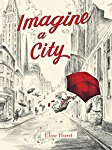 Imagine A City
Imagine A CityElise Hurst
Picture Book
For ages 5 to 7
Random House, 2016, 978-1-101-93457-9
Imagine if you can what it would be like to get on a train, a train that is going to take you to the city so that you have a special outing. It is an ordinary train that stops at an ordinary train platform. You get on board and off you go. It is not long before a waiter comes around and serves you a luscious tea. You sit on the comfortable seats sipping hot tea and eating delicious little cakes and treats. Perhaps you notice that one of the passengers in the car has rather long ears, and paws instead of hands. Or perhaps you don’t.
When you get to the city ordinariness disappears. Here humans and animals live side by side, and there are many strange and wondrous things going on. The pictures in a gallery that you visit refuse to be contained by their frames. Here the buses are fish instead of machines and they swim through the sky above the streets. Here the stories in books, like the pictures at the gallery, will not lie down quietly on the paper. Instead they hop off the pages and sometimes you get quite a shock!
When you stop for a bite in a little restaurant you find that the tables and chairs are little trees. In addition to the now no longer unusual assortment of animals, there are gargoyles partaking of drinks and snacks. It is important to remember that when you can imagine a city there is no accounting for what might happen.
In this visually stunning picture book, the author takes us on a journey full of wonderful impossibles and glorious imaginings. A minimal, lyrical text accompanies the art, and together they capture the sense of a place where adventures lie around every corner and where “The World is your teacher.”
This celebration of the imagination will delight readers of all ages, many of whom will wish that they could jump into the pages and visit the land that lies therein.
Every September I look forward to fall. I am eager for cooler days, rain (after weeks and weeks of dry weather), and the treats that the fall season brings. Apples, pears and pumpkins start to appear in the farmer's market, and I start thinking about making apple and pumpkin breads and coffee cakes. It is a time of change and new beginnings for me.
Today's poetry title tells the story of a young girl whose uncle has suffered a great loss, and who comes to visit her and her family as the apples are starting to fall from the tree in their yard. For him this is a time for reflection, and though he does not know it at first, it is also a time for new bittersweet beginnings.
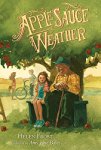 Applesauce weather
Applesauce weatherHelen Frost
Illustrated by Amy June Bates
Poetry
For ages 8 to 10
Candlewick Press, 2016, 978-0-7636-7576-9
Faith has been waiting for this day, the day when the first apple falls from the apple tree that Aunt Lucy planted all those years ago. Over the years Uncle Arthur and Aunt Lucy would always arrive at Faith’s house on this day. Somehow they always knew when the first apple fell. Then Aunt Lucy died and Faith’s parents and brother believe that maybe Uncle Arthur will not come this year. Little Faith does not lose hope though. She waits for Uncle Arthur.
At his home Uncle Arthur thinks about his beloved Lucy and remembers how his wife always knew when the first apple had fallen, when it was time to gather with the family to pick apples and make applesauce. He does not know if he can bear to go without her, or if the family is even expecting him.
Faith’s big brother Peter thinks Faith is being silly. She should give up waiting and accept that Uncle Arthur is not coming. Then, to everyone’s surprise, Faith’s faith in Uncle Arthur is rewarded, and in the evening of that day the old man arrives.
Every year Faith asks Uncle Arthur what happened to his missing finger - he only has four and half fingers on his right hand – and every year he tells her another story (a tall story) of what happened to his finger. This year he seems reluctant to tell the stories so beloved by everyone in the family. This year he is quieter. He is wrapped up in the memories of the times he shared with the girl and woman who became his wife. He remembers how he and Lucy, who were neighbors, became friends, and how their friendship grew into love when they were teenagers. He looks at the house where she used to live and remembers how he used to wait at night to see a light blinking in her window, which was her message telling him that she loved him.
Faith seems to know that Uncle Arthur is feeling lost and so she holds his hand, the one missing half a finger, and she says nothing. Faith wonders if her uncle has no more stories to tell but she does not ask. Instead, she walks down the road with him every day and she tells him that Peter is sweet on the girl who is living in the house that Lucy lived in all those years ago. Once again a boy in her house, Uncle Arthur’s old house, is falling for a girl who lives in the house a few doors down. Uncle Arthur smiles and he starts to tell them a story, a true story about how he got a knife when he was Peter’s age and how he used the knife to carve his initials, and Lucy’s, into the bark of the apple tree. The initials are still there.
The apples start ripening “faster / than we can pick them” and Faith and Peter go to the tree to collect as many as they can. Uncle Arthur then indicates, in his own way, that a story is in the offing and so Faith sits with him on the bench under the tree and asks the question that they have all been afraid to ask: “what happened to your finger?”
This wonderful story is told from the points of view of Faith, Peter, and Uncle Arthur. We also hear from Aunt Lucy, who gives us a wonderful picture of what her life with Uncle Arthur had been like. The narrative is presented in the form of rhyming and blank verse poems, and we are taken on a journey that spans decades, and also on a journey that encompasses a few autumn days when the apples are ripening. We see, through the words of Faith, Peter and Uncle Arthur, how healing after a loss can begin and how there is much joy to be found in stories. Sometimes these stories help us to connect with the people who are no longer with this, making it possible for us to stay linked to them.
Last weekend I had the time of my life steeped in poetry with 150 other people who love it as much as I do. On October 1, Western Washington University’s PoetryCHaT center was the proud host of “Poetry Camp 2016,” the first-ever national conference dedicated solely to poetry for children and teens. Nearly forty children's poets, including the first Children’s Poet Laureate, Jack Prelutsky, came from California, Georgia, Hawaii, Illinois, Louisiana, Ohio, Oregon, Massachusetts, New Jersey, New York, South Carolina, Washington, Washington, DC, and even Japan to join teachers, librarians, and poetry fans in a day packed with sessions on poetry performance, writing techniques, curricular connections, and s’more(s). These were the participating poets:
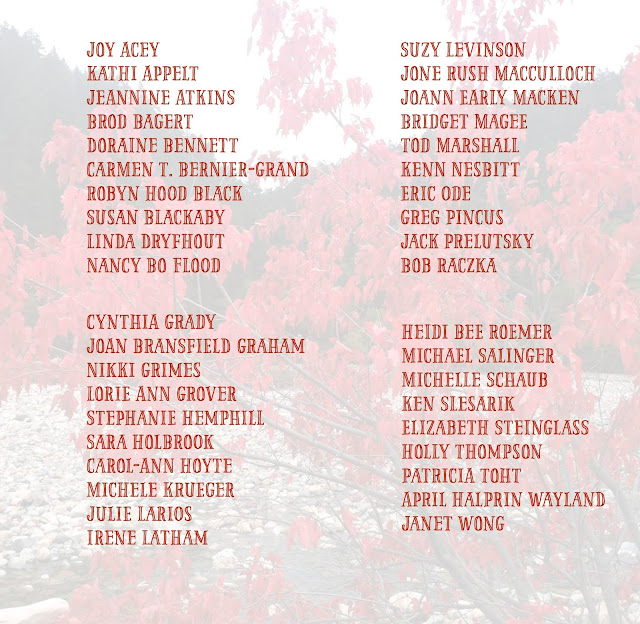
The Friday before Poetry Camp, Janet (Wong) and I spent the day with the 38 poets meeting one another (many for the first time), getting acquainted, chatting informally, and engaging in lively discussions about the value of performing poetry out loud while honoring those who prefer quiet reading or savoring visuals. We had several guest speakers including Kathy Humphrey on using social media effectively, Paige Bentley Flannery on school and library visits, Michael Salinger and Sara Holbrook on conference presentations and Julie Larios on poetry writing tools and techniques. The camaraderie and energy was something to behold! Then in the evening, poet and artist Robyn Hood Black led a Makerspace workshop that was so fun and inspiring.

Saturday was the BIG day of Poetry Camp and Janet and I led two keynote talks and featured all the 38 poets reading their own poetry in rapid fire succession. The audience was so thrilled to hear so much poetry read by the poets who wrote it! In between everyone chose three sessions to attend all led by poets on a wonderful variety of topics including: playing with sound, playing with visuals, metaphor and simile, verse novels, poetry performance, writing for journals, publishing anthologies, blogging about poetry, and poetry and STEM, as well as grammar, social studies, movement, art, and music. I wish I could have sat in EVERY session! I rotated through to take photos and they all seemed marvelous!
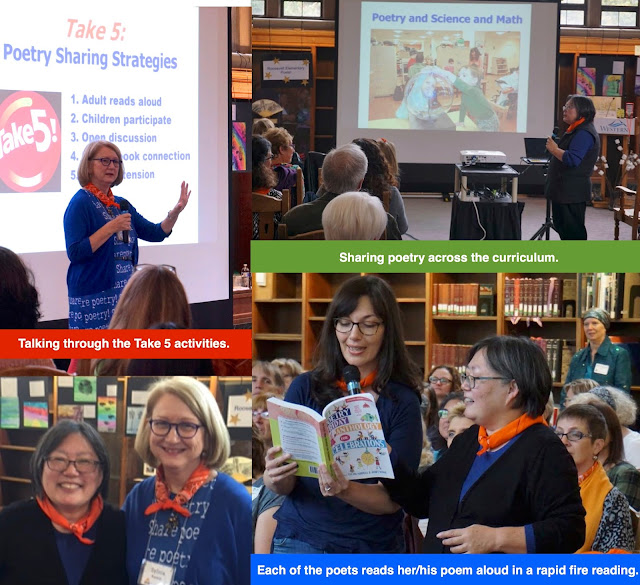
Then at the end of the day, the first Children's Poet Laureate Jack Prelutsky performed his poetry (singing and yodeling and shouting along with his guitar) to an audience of all ages that was completely enthralled! Two groups of children had also prepared dramatic readings of Prelutsky's poetry and they did such a great job-- complete with motions and humor!
The organizers of PoetryCHaT’s Poetry Camp 2016 were Sylvia Tag and Nancy Johnson:
Sylvia Tag is Librarian/Associate Professor and curator of the WWU Libraries Children’s Literature Interdisciplinary Collection.
Nancy Johnson is Professor in the English Department, specializing in children’s and young adult literature and English/language arts education.
They did an amazing job in organizing this fantastic event and emceeing throughout the day!
What is PoetryCHaT?
A collection of resources, ideas, and curricula designed to help poets and educators share their love of poetry with children and teens. The WWU PoetryCHaT Children & Teen Poetry Collection includes a growing collection of materials written and published since 1920 for children and teens, birth through age 20. PoetryCHaT sponsors programs, special events, and readings that celebrate poetry. Their inaugural programming this past spring featured poet Kwame Alexander.
Press coverage included a local television station airing more than one hour of video clips of poet readings. You can see a summary of the day’s activities at the Poetry CHaT site and can see more photos on the Poetry CHaT Facebook site.
My favorite photo was of all 38 poets and me standing on the library steps. What a beautiful, generous, smart, funny, and lovable group! What a treat to meet all these writers whom I admire and spend time together laughing and learning!
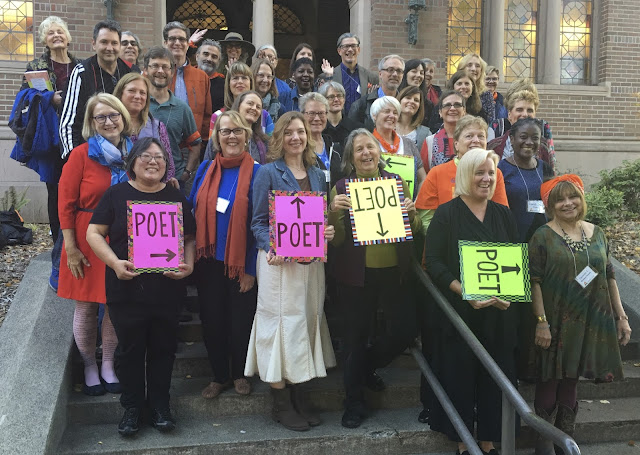 I also enjoyed meeting this week's Poetry Friday host, Violet Nesdoly at Poetry Camp! And just now as I looked for her link, I saw that she is also sharing her experiences at Poetry Camp! So check out more photos and comments there. She's done a marvelous job capturing the joy and energy and personalities too!
I also enjoyed meeting this week's Poetry Friday host, Violet Nesdoly at Poetry Camp! And just now as I looked for her link, I saw that she is also sharing her experiences at Poetry Camp! So check out more photos and comments there. She's done a marvelous job capturing the joy and energy and personalities too!
When I was a child I struggled to understand mathematics. Numbers became my worst enemy and it did not help that I was often ridiculed by my peers when I made mistakes. I even had a teacher who made fun of my struggles, which was terrible. If only I had had the kind of help the little girl in today's book gets when she is trying to learn how to read. Kind, non-judgmental support goes a long way when it comes to learning how to do something that is difficult.
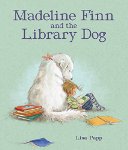 Madeline Finn and the library dog
Madeline Finn and the library dogLisa Papp
Picture Book
For ages 5 to 7
Peachtree Publishers, 2016, 978-1-56145-910-0
Madeline Finn does not like to read. At all. Anything with words, including the menu of the ice cream truck, is to be avoided. Reading out loud is the worst because then people can hear how she sometimes struggles to make sense of the words, and on occasion they “giggle” when they hear her mistakes. No matter how hard she tries, Madeline Finn’s teacher never gives her a star sticker. Instead, she gets a heart-shaped “Keep Trying” sticker, which is so frustrating.
Madeline Finn wishes very hard that she will get a star of her own, but day after day her reading efforts just aren’t good enough. On Saturday Madeline Finn and her mother go to the library. Madeline Finn reminds the librarian that she does not like to read, which is when the librarian, Mrs. Dimple, shows her a surprise.
The children’s reading area is full of dogs. Real live dogs, and apparently they are there to be read to. Mrs. Dimple introduces Madeline Finn to Bonnie, a beautiful, big, white dog who is apparently a “great listener,” and in spite of herself Madeline Finn decides that she would like to try reading to the dog. She never imagines that Bonnie is going to be more than a good listener.
This wonderful, heartwarming picture book explores one little girl’s reading journey. It is a journey that is full of struggles, frustration, and heartache, but it turns out that a patient and accepting dog is just want the little girl needs.
With an authentic first person narrative and wonderful illustrations, Lisa Papp tells a story that will resonate with everyone who has struggled to learn how to do something new.
Over the years I have encountered several poetry collections where poets have take other people's writings and have changed them in little ways to make them accessible for young readers. Often the changes add touches of humor to the poems. In today's poetry title, Iza Trapani does this to great effect, taking young readers into the school life of a little dog character.
 Rufus and Friends: School Days
Rufus and Friends: School DaysIza Trapani
Poetry Picture Book
For ages 5 to 7
Charlesbridge, 2010, 978-1-58089-249-0
It is a rainy day, Rufus is off to school, and he “can’t wait,” because “My teacher and my friends are great.” As he hops on the school bus he invites us to join him. When they arrive at school the little dog children march into the building and head to their classrooms, though Rufus has to pause for a moment “to suck his thumb.”
Once Rufus and his friends are in their classroom they begin their day. They have a “busy day” ahead full of writing, reading, drawing, and will learn “some things worth knowing.”
Presiding over the classroom is a “neat little clock” which “points to the time / With its two little hands.” The clock always has a clean face and those hands are always ready “To do what is right.” One can hope that the children in the class will have similarly clean faces and ready hands, but sometimes things do not go “as we planned” and the students, despite all their good intentions, end up with paint and glue in unexpected places.
After several hours of laboring away, the children have lunch, which is most unappetizing, and then they go outside to play. The children jump rope, throw a ball around, or play on the swings and slide, but Joan, who loves “books a lot” finds a spot under a tree to read a book. With a book in hand Joan never feels alone.
In Mrs. Alegro’s music class the children have a grand time playing musical instruments of all kinds. Tom-Tom is a wonderful flute player and he tootles away to the delight of his classmates. Later, in the library, the children are not as well behaved as they should be. They talk, wriggle, and giggle. They are rambunctious and the librarian is not at all happy.
In this splendid poetry picture book Iza Trapani presents children with some traditional poems which she has “extended” in creative ways. Taking us through the school day, she gives us familiar poems such as
One, Two, Buckle My Shoe, and songs such as
The Ants go Marching. There are also poems that children may not be familiar with, but which offer readers wonderful opportunities to enjoy the written and spoken word.
Over a year ago, Sylvia Tag (librarian) and Nancy Johnson (professor), at Western Washington University, had the idea to host a "Poetry Camp" and invited Janet (Wong) and me to come and speak. Of course we said YES! Then Janet had the idea of inviting poets we know if they'd like to come and join us. And 40 poets said YES YES YES! And now the time has come and we're gathering in Bellingham, Washington, at the WWU Poetry CHaT Center for poetry for young people with 100+ others to talk poetry, make poetry art, share poetry ideas, and just plain have fun together! Here's the lowdown on the Saturday conference activities.
But first, we gather with just the poets to share ideas and have fun. Kathy Humphrey is presenting social media strategies. Paige Bentley Flannery, Sara Holbrook, and Michael Salinger are sharing presentation tips. JoAnn Early will be talking about publishing and Julie Larios will inspire us with Oulipo Leaping ideas. Then Robyn Hood Black will lead us (and the public at large) in a fun Makerspace activity night. What a blast!
The 40 poets presenting this weekend?
Janet helped create a special Poetry Camp celebration book of poems by each of the 40 participating poets and I've adapted that into a mini-slideshow. Plus, we're talking about sharing poetry everyday and making connections across the curriculum. (Hope to share details about all of that later.) So excited to meet each of these people IN PERSON and spend a few days reveling in poetry, writing, sharing. I plan to share photos and nuggets from this amazing experience afterward. Stay tuned.
For the rest of the Poetry Friday gathering, go to Karen's place here.
For many young people today a book is digital file on a tablet. Print books just aren't a part of their lives. I read books in both formats but I generally prefer a printed book. There is something about how a book feels, how it looks sitting on a shelf, and even how it smells that I love. I have books in almost every room in my home, and book cover images appear in frames on my walls.
In today's picture book you will meet a character who has no idea what a print book is. He is puzzled by the book that his friend is reading because it cannot be twitched on, it doesn't noises, nor can you play games on it. What is the point of a book he wonders. What indeed!
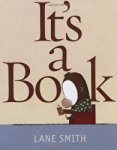 It’s a book
It’s a bookLane Smith
Picture Book
For ages 5 to 7
Roaring Brook, 2010, 978-1-59643-606-0
One day Jackass comes over to where Monkey is reading. Jackass asks Monkey what he has in his hands. Monkey explains that it is a book. Jackass is not sure what a book does so he asks Monkey a lot of questions about the strange object that he is holding.
Jackass wants to know if you can scroll down with a book or blog with it. Does it have a mouse? Can it make characters fight? Does it tweet or use wi-fi- or make noise like Jackass’s laptop? It turns out that a book cannot do any of these things. Monkey shows Jackass that the book he is reading has a story in it about pirates. In Jackass’s opinion there are too many words. As he takes the book and goes to sit down, Jackass learns that the book does not even have a screen name, nor do you need a password to read it. How bizarre!
This wonderful book shows young readers all the things that a book isn’t. Then, in a sneaky and completely silent way, it shows us the wonderful magic that can be found in an object that does not need a power cable, upgrades, or a mouse pad.
With a minimal text, delightful characters, and touches of humor, Lane Smith gives readers a fantastic reading experience.
Animal characters play important roles in many children's books, allowing authors to connect with their young readers on many levels. Children begin with Babar the elephant in picture books and work their way up to to the gripping animal-rich adventures in the Redwall novels. Poets also love to write about animals, and in today's poetry title animals of all kinds can be found on the pages to offer children a wonderful poetry-filled book experience.
 Beastly Verse
Beastly VersePoems selected and illustrated by Joohee Yoon
Poetry Picture Book
For ages 5 to 7
Enchanted Lion, 2015, 978-1-59270-166-7
Children love poems about animals, especially ones that are about creatures that a big and scary. Over the years poets have chosen to write poems about animals of all kinds, including those that we love to be afraid of. In this collection Joohee Yoon has brought together some of these poems and paired them with her colorful print illustrations.
We begin with Lewis Carroll’s poem about the “little crocodile” who seems to grin so “cheerfully” and who “neatly spreads his claws.” So friendly does the crocodile seem that it is as if he is welcoming fish to swim into his “gently smiling jaws.”
Another creature with claws and teeth is a tiger and William Blake’s famous poem about a tiger perfectly captures the awe that the poet feels for the animal that has fire in its eyes. He wonders what “immortal hand” created the tiger’s “fearful symmetry.”
The mood is lightened in the poem that follows, where we meet a happy hyena. This animal can play the concertina and is very particular about his appearance. A master of sartorial elegance, the hyena even has a flower stuck into his lapel.
A few pages later we encounter someone who is trying to tell us about an elephant who “tried to use the telephone.” It turns out that a trunk is not the best of appendages to use when one is trying to make a telephone call. It also turns out that the narrator of this poem cannot help getting his or her words frightfully, and hilariously, mixed up.
For children who fancy having an unusual animal for a pet there is the poem The Yak. In it we hear about how a yak is a perfect pet for young people. After all it “will carry and fetch, you can ride on its back, / Or lead it about with a string.” The Tartars who live in Tibet have been keeping yaks as nursery pets for centuries, so if they can do it why can’t you?
Animal loving children are sure to love this clever collection of poems. On the pages they will find verses that are often humorous, that offer up wonderful descriptions, and that sometimes give readers cause to pause.
It's time for another installment in my Poet to Poet series where one poet interviews another poet about her or his new book. This time, the lovely April Halprin Wayland interviews Jeannine Atkins about her new nook, Finding Wonders.
 |
| Photo by Webb Burns |
April Halprin Wayland is a poet and picture book author and one of the founding members of the Teaching Authors blogging team and the UCLA Extension's Creative Writing Instructor of the Year. Her works include the novel in verse, Girl Coming in for a Landing, and New Year at the Pier, a Rosh Hashanah story, and More Than Enough, a Passover story, as well as To Rabbittown, It's Not My Turn to Look for Grandma, and The Night Horse. She's a violinist, a political activist, and a frequent speaker, as well as the recipient of a Sydney Taylor Book Award.
 Jeannine Atkins is a poet and author of novels in verse, biographical works, picture books and nonfiction with a particular focus on girls, science, and nature, many inspired by history including this history-biography-in-verse, Borrowed Names About Laura Ingalls Wilder, Madame C. J. Walker, Marie Curie, and Their Daughters. She also published her first novel for adults about May Alcott, Little Woman in Blue. She blogs at Views From a Window Seat and founded her own publishing company, Stone Door Press. Her new book is Finding Wonders: Three Girls Who Changed Science, about the fascinating lives of Maria Merian, Mary Anning, and Maria Mitchell.
Jeannine Atkins is a poet and author of novels in verse, biographical works, picture books and nonfiction with a particular focus on girls, science, and nature, many inspired by history including this history-biography-in-verse, Borrowed Names About Laura Ingalls Wilder, Madame C. J. Walker, Marie Curie, and Their Daughters. She also published her first novel for adults about May Alcott, Little Woman in Blue. She blogs at Views From a Window Seat and founded her own publishing company, Stone Door Press. Her new book is Finding Wonders: Three Girls Who Changed Science, about the fascinating lives of Maria Merian, Mary Anning, and Maria Mitchell.Here, April asks Jeannine questions about this new book, Finding Wonders.
APRIL:
Jeannine, your metaphors and similes are breathtakingly original. As I read your book, you pulled me in with your deft use of language from the first page. So my question is: can you teach me how to come up with jewels such as the few I've listed below?
 "...witch. That word sets hooks under her skin,/like the tiny barbs on the backs/of caterpillars' legs that help them climb."
"...witch. That word sets hooks under her skin,/like the tiny barbs on the backs/of caterpillars' legs that help them climb.""They exchange a glance,/swift and silent as two moths meeting in midair."
"Her voice scatters like sharp pieces of broken crockery/that can't be repaired, and will be hard to forget."
"Coughs scrape the air, as if Pa breathes through a grater."
"A constellation of sisters in one bed."
JEANNINE:
I begin with real things that were part of a person’s daily life and work. I imagine some cluttered on my desk and looking at them from different angles, trying to find language for them beyond their names. As I stick with an ordinary object, playing with its colors, uses, shapes, and scent, it seems richer - or it doesn’t, in which case it gets left behind. As I try putting details in poems, some seem to whisper to the theme. A metaphor may slip out, connecting something small to the big world.
APRIL:
You never fail to include evocative details, clearly culled from long hours of research. Tell us how you research... and how you choose just enough details to weave it into your story, such as the following:
"Mum gathers bee balm, foxgloves, and thistles/to make tinctures and teas she says will help/ Pa breathe easier or tame his aches. She is careful/ not to disturb spirits by spilling salts, dropping a knife,/or setting a loaf upside down on the table./ She holds up an apple cut in half,/showing how her knife didn't slit a single seed./That means blessings are coming. She scoops out bits of the soft apple for the baby, feeds/ him wedges curved like half-moons." "For dinner, they must change from gingham dresses to silk,/and when biting into bread, be vigilant not to leave a vulgar/horseshoe shape."
JEANNINE:
Some poets begin with voice, but I start and move along by giving time to words that evoke the five senses. I read for the shapes of lives, but while slogging through summary and abstraction, am on the lookout for particular tools, clothing, animals, food, or furniture. My process is to read and write a lot – because I don’t know when I start out what will be valuable – then get out the scissors.
APRIL:
You keep the lives of these scientists real. My final question is: if we were to go back in time and see you as a young child, would we see a budding scientist? Some examples of how you show how scientists think and how they work:
"...Mary considers. Certainty is like a pillow/ she has learned to live without./ Doubt is crucial. Discoveries are made/ by those willing to say, Once we were wrong,/ and ask question after question. Every one is a gift."
"She becomes as familiar with the creature as her own body./ No, more. Her tenderness toward the stone is long,/ while at home she spends just seconds pulling a comb/ through her hair, scrubbing grime from her fingernails,/or tucking her feet into stockings."
 "Mary believes that the Lord loves questions as well as answers./ People were given scripture, but also the earth./ She means to read both."
"Mary believes that the Lord loves questions as well as answers./ People were given scripture, but also the earth./ She means to read both."
JEANNINE:
I grew up in a small town at a time when parents let children wander or bicycle around. I was curious about what I saw in fields and woods, but shortly after a delicious classroom assignment to press and take apart a dried flower to label the parts, science moved toward abstractions, and my interest waned. Would it have made a difference if all my science teachers hadn’t been men? If I’d known of women besides the singular Marie Curie who’d made careers in science? I don’t know. But I’m happy. Writing and science find common ground in the need for wonder, working through mistakes, and paying close attention to the world.
Thank you, April and Jeannine, for digging deeply into poetry and sharing your conversation with us. Fascinating!
Here's a quick list of previous Poet-to-Poet interviews. FYI.
Julie Larios & Skila Brown
Jane Yolen & Lesléa Newman
Joyce Sidman & Irene Latham
Laura Purdie Salas & Nikki Grimes
Helen Frost & Chris Crowe
Holly Thompson & Margarita Engle
Allan Wolf & Leslie Bulion
Margarita Engle & Mariko Nagal
Carole Boston Weatherford & Jacqueline Woodson
Not long ago we brought a new kitten into the household. Our two dogs were thrilled to bits to have a new playmate, but the two cats were appalled and disgusted. They behaved as if a fate worse than death had been placed upon them, and were rude and anti-social for days. Thankfully, the kitten's charms have started to wear down the older cats' standoffish behavior. There is only so much you can do when a little furry person snuggles up against you.
In today's picture book you will see what happens when a large and indulged cat called Fuddles gets a new housemate who is.....prepare yourself.....a puppy!
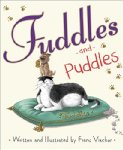 Fuddles and Puddles
Fuddles and PuddlesFrans Vischer
Picture Book
For ages 5 to 7
Simon and Schuster, 2016, 978-1-4814-3839-1
Fuddles is a fat, lazy, and utterly content cat. His people spoil him rotten and that is exactly how things should be. According to Fuddles. Then one day Fuddles wakes up from a nap, he goes into the kitchen, and he sees that there is a puddle on the floor. Worse still there is a little dog that goes with the puddle. A dog that barks and drools, and makes puddles. Fuddles is “disgusted” and he wants nothing to do with the dog.
Unfortunately, Puddles does not seem to understand how much Fuddles dislikes him. The little dog follows Fuddles everywhere, even to the litterbox. Fuddles hardly gets a break from the little pest and one day, when Fuddles catches Puddles eating his food, the cat loses his temper. He has had enough, and so he yowls and is so frightening that the dog runs away and he stays away. Fuddles is “delighted.” He has got rid of the dog pest and now life can settle down and go back to the way it was.
All is well until Fuddles gets himself into a dreadful situation; a situation that means that he needs help and he needs it quickly.
Many of us hate it when change comes into our lives, especially when that change brings inconveniences and perhaps a little chaos with it. What we often don’t realize is that change can actually be a good thing; it can bring unexpected gifts with it that we did not even know about.
With wonderful touches of humor and an appreciation for human (and cat) nature, Frans Vischer brings us a third Fuddles story that will delight readers of all ages.
Many adults and children in the Unites States can remember where they were on September 11, 2001, when terrorists attacked targets in the United States using commercial airplanes. What we sometimes don't realize is that the ripple effects of the tragedy spread far from our shores to people all over the world, many of whom were profoundly effected by what happened.
Today's title is a novel in blank verse that takes us to Japan where a young girl, a half Japanese and half American girl, is facing a lot of personal problems of her own in the months leading up to the September 11th attacks. The appalling events of that day add to what is already a painful situation, and we see, through her eyes, how violence damages people's ability to hope, and takes away their ability to feel safe.
 Somewhere Among
Somewhere AmongAnnie Donwerth-Chikamatsu
Poetry
For ages 12 and up
Simon and Schuster, 2016, 978-1-4814-3786-8
Ema lives “between two worlds.” Her father is Japanese and her mother is American, and sometimes being “half this / half that” is not easy to manage. Though her mixed heritage makes her life interesting at times, the fact that she is different also means that at times she feels “alone / on an island / surrounded by multitudes / of people.”
Every August Ema and her mother go to California for a month to spend time with Ema’s maternal grandparents. This year is going to be different. Ema’s mother is pregnant and it has been a very hard pregnancy with scares and all-day-long morning sickness. Her mother has lost babies in the past and so this time they are going to be very careful, which means that the family is going to go and stay with Ema’s paternal grandparents, Obaachan and Jiichan, until the baby is born. Thanks to these new arrangements Ema will miss six months of fifth grade in her school, she and her Papa will not be having a vacation by the sea, and she and her Mom will not being to California.
Ema and her parents travel to western Tokyo to Obaachan’s house, and it isn’t long before Obaachan stars fussing, criticizing, and complaining. She likes everything to be just so and she has very strong opinions about how things should be done. Often she does not understand that Ema’s mother, being an American, does things differently. For example, Mom does not like to use bath water that other people have used, and she prefers western cakes to Japanese desserts. The differences between the two women creates tension and this tension only becomes worse when Ema’s father goes back to the city. Commuting to and from his parent’s home simply isn’t going to work and so Ema and her mother are going to have cope being in Obaachan’s world as best they can. Ema often wishes that she and her mom could be back at home, even though home is only a small one-room apartment. At least the TV is not on all day long, and at least there they don’t have to deal with Obaachan and her persnickety, old-fashioned ways.
The summer is hot and hard on everyone but when school starts things get even harder for Ema. There is a boy at school, Masa, who goes out of his way to make Ema miserable. He hits her, steals the NASA space pen that Grandpa Bob gave her, trips her, and is generally disagreeable as much as possible. Ema is not sure how she is going to cope with this and then something happens that makes everyone forget about the little things. Terrorists attack the Twin Towers in New York City and in two other places. Mom is distraught, Ema is upset, and everyone is in shock over what has happened. Ema, Papa and the grandparents all worry that the anxiety and distress that Ema’s mother is experiencing will hurt the baby. How can all the hurt, both in their home, and in the wider world, not affect them? Ema wants to protect her mother but it would seem that there are some things that she cannot prevent. Sometimes Ema wishes she could escape the world and go out into space where she won’t have to “see or hear or feel / any more sadness.”
This remarkable book takes us into the life of a Japanese child whose world is in a state of flux. The things that make her feel safe and secure are taken away from her and then, just to add to her distress, the attacks on 9/11 take place. Written in blank verse, this extraordinary narrative is touching and often painful, but ultimately Ema comes to learn something very valuable that she is able to pass on to the grownups in her life. Anyone who has had their life disrupted by change and loss will appreciate what Ema goes through.
Happy Book Birthday to You Just Wait!
Today, Janet (Wong) and I are officially launching another poetry venture and we’re trying something different once again. It's entitled You Just Wait: A Poetry Friday Power Book. Our special focus is always linking poetry with teaching and learning—all in one book. Usually, our audience is teachers, librarians, parents, and other adults. This time, we’re focusing on young people themselves, particularly on teens and tweens with a new, slim book that is part poetry, part road map for thinking-responding-writing poetry themselves.
Here’s the deal:
You Just Wait: A Poetry Friday Power Book is a mashup of:
- Poems from an anthology
- Plus new poems written in response to those poems
- Plus creative activity pages to jumpstart thinking, brainstorming, responding, and writing
These are all linked together with a story thread involving friends, siblings, sports, school, movies, and dreams.
The twelve poems at the root of this book come from our previous collaboration, The Poetry Friday Anthology for Middle School (an NCTE Poetry Notable), and were written by Robyn Hood Black, Joseph Bruchac, Jen Bryant, Margarita Engle, Julie Larios, Carmen T. Bernier-Grand, Charles Ghigna, Avis Harley, Amy Ludwig VanDerwater, Charles Waters, and Virginia Euwer Wolff.
Then Janet Wong created two dozen new poems to join them together in a story featuring Paz, an Asian-Latina soccer player with dreams of stardom in college, the Olympics, and ultimately the World Cup; Lucesita, her feisty movie-loving cousin; and Joe, an older brother with dreams of the NBA.
You can read the book simply for the poems and the story—a novella in verse.
And you can scribble right in the book to interact with the poems as a reader and a writer.
For the educator, the structure of the book provides a five-part model for instruction with each of the following components ideal for guiding the reading, responding, and writing process:
*PowerPlay Activity
*Outside Poem
*Response Poem
*Mentor Text Poem
*Power2You Writing Prompt
There are a dozen of these PowerPack sets of 5 linked activities each with a slightly different focus encouraging readers to consider the elements of repetition, rhyme (including internal rhyme), structure, dialogue, and form (list poems, prose poems, sequence poems, cinquain, poems of address, concrete/shape poems, acrostic poems, found poems, and odes).
Here’s one sample PowerPack showing each of the five components for PowerPack #7.
*PowerPlay Activity
*Outside Poem
*Response Poem
*Mentor Text Poem
*Power2You Writing Prompt
 |
| #1 PowerPlay activity |
 |
| #2 Outside Poem & #3 Response Poem |
 |
| #4 Mentor text & #5 Power2You Writing Prompt |
In addition, aspiring writers will find helpful backmatter with a poetry self-edit checklist and lots of other lists, including places to publish teen poetry, books of poetry by teen writers, books for young people about writing poetry, collections, anthologies, and novels in verse, websites, talking points, and performance tips.
Please help us spread the word, as we reach out to young readers with a book they can read, ponder, respond to and write in.
We’re offering 5 free copies of our new book to a commenter chosen at random, so you can gather a group to read, discuss, share, scribble, and write together. This can be for a small writer’s group, a Reading Recovery session, an ELL teacher with a small middle school cluster, an eager book group, or a homeschool session. Comment below this blog entry please.
Buy your copy now and some for your favorite teacher, too! Here’s the link.
Note: Some vendors such as QEPBooks.com are offering healthy discounts this month as part of the book’s promotional launch; please consider ordering some copies for your school or library.
Now, head on over to Amy's place at the Poem Farm for more Poetry Friday goodness!
In 2013 a wordless picture book called Journey came out and it caused quite sensation in the children's book world. In this debut book Aaron Becker tells the story about a little girl who uses magic crayons to go on an adventure. In his next book, Quest, the little girl goes on another journey, one that is packed with even grander adventures, and this time she has a companion with her. Today's picture book is the final title in the trilogy, and just like the first two books in the series, it is wonderfully rich and suitable for anyone who loves beautiful art and storytelling.
 Return
Return
Aaron Becker
Wordless Picture Book
For ages 6 and up
Candlewick Press, 2016, 978-0-7636-7730-5
One day a little girl tries to get her father to spend some time with her, but he is so busy working at his drafting table that she finally gives up, goes downstairs, and uses her magic red crayon to draw a doorway on her bedroom wall. Her father finally realizes that she has gone and so he goes downstairs to investigate, which is when he sees the red door in her bedroom.
The father goes through the door and finds himself in a beautiful forest where lamps hang from the trees. His daughter’s red ball is sitting at the end of a wooden dock. The father picks up the ball, which is when a self-propelled boat sails up the river. The man gets on board and by the light of the moon he travels to a fantastic city. He can see his daughter, who is sitting in a little red rowboat, on the river ahead of him.
When the father finally catches up with his daughter she is with a boy, the king of the land, and a beautiful purple bird. The girl is clearly upset with her father for his neglect earlier and she has no interest in trying to make up with him. Just then the boat the father arrived in opens up and soldiers come out of it. They threaten the king, who responds by using a yellow crayon to draw a sword. The king tries to defend himself, but one of the soldiers uses a special device to suck up the sword, the yellow crayon, and the other crayons the king has. The king and the magical box are then whisked away by the enemy.
The boy quickly draws a large purple gryphon with his crayon and then he and the girl and her father climb on the animal’s back. They fly in pursuit of the kidnappers. They are close to the enemy when one of the soldiers opens the device to suck up the gryphon. The boy is captured by the enemy, but the purple bird, father and daughter fall through the air and land in the water far below. How are they going to save the king and the boy now?
This is the third book in a trilogy that tells the story of a pair of children who use magic crayons to travel to a world that is full of marvels and adventures. Once again the children are called upon to save the day, but this time the girl’s father also has to redeem himself in the eyes of his daughter, who is clearly sorely disappointed in her parent.
Readers of all ages are going to thoroughly enjoy this rich and exciting wordless picture book.
For many children a new school year has started and they are getting used to new schedules and teachers, and making new friends. When they get home many children chatter away busily, telling their grownups about the things that they did during the day.
In today's poetry picture book you will meet a little cat who has some wonderful school stories to share with his mother when he gets home.
What a day it was at school!
 Jack Prelutsky
Jack Prelutsky
Illustrated by Doug Cushman
Poetry Picture Book
For ages 5 to 7
HarperCollins, 2009, 978-0060823375
The school day is over and the little cat heads home. When he gets there, he and his mother sit at the table and the little cat has some milk and cookies. As he sips and snacks, the little cat tells his mother about his day, the details of which are all noted down in his journal. Now the journal is full of stories and commentaries that we get to read.
In the first one we get to hear about how put upon the young cat feels because his “backpack weighs a thousand pounds.” Sometimes it is so heavy that he tips backwards and has to stop and rest by leaning against a wall. No matter how much he pleads, his teacher refuses to let him “lighten” his load.
In another entry we hear about how the cat and his friends had a loud and rambunctious time making music together. They shook maracas, beat drums, tooted on kazoos, and played every noisy percussive instrument that they could get their paws on. They had a wonderful time, and to them the sounds they made were “so sweet.”
The cat also tells us about a field trip that he went on the day before. This year the field trip was “really special” because they visited a factory “To watch candy being made / And saw a million lollipops / On colorful parade.” They saw so many fabulous things, and got lots of samples to try. One can only imagine what the experience was like for their teacher and for the people who worked at the factory.
During library time the little cat read a book about knights. Having a powerful imagination he began to imagine that he was the one who was a “knight / On a powerful steed.” He would be the kind of fellow who would “conquer a dragon” and “vanquish a troll.”
Children are going to thoroughly enjoy this collection of poems. Each poem is accompanied by amusing illustrations, and together they capture moments in a little cat’s school day, some of which are everyday sort of events, and some of which are deliciously outrageous.
Learning how to deal with problems is a vital skill to have. The funny thing is that many of us have no clue what to do when things go wrong. We wring our hands, have a panic attack, moan and groan, or burst into tears. We try to run away from our problems, or pretend that they are not there. Needless to say, none of these strategies improve our situation in the slightest.
Today's picture book will help readers of all ages to better understand how to deal with a problem. The narrative is beautifully presented without being preachy or pedantic. The story is supportive and it helps readers to think about their problems in a new way.
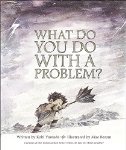 What do you do with a Problem?
What do you do with a Problem?Kobi Yamada
Illustrated by Mae Besom
Picture Book
For ages 5 and up
Compendium Inc, 2016, 978-1-943200-00-9
One day a little boy finds out that he is saddled with a problem, a problem that he does not like, did not ask for, and does not want. He has no idea what he is supposed to do with the problem or what it wants, and not surprisingly he would like it to go away. He tries shooing it, scowling at it, and even ignoring it but nothing works.
The thing about problems is that they can cause a lot of new problems. People worry about them, and get anxious that their problem will do something to them or change their life in some dreadful way. The worry builds on itself and unfortunately this only makes the problem bigger.
No matter what the little boy does his problem can always find him, and the more he tries to avoid it “the more I saw it everywhere.” The problem is taking over his life!
No matter how old you are problems can get the better of you. They worry at you and make you so miserable that you start to feel as if your life is just one big, uncontrollable problem. Thankfully the author and the illustrator of this remarkable book understand exactly what this feels like, and they offer readers support that is simple and yet profound. It turns out that problems contain something special and surprising.
For most of us humans, the process of getting our food is relatively simple. We go to a shop or a market and buy what we need. For animals, this process is more complicated. Food has to look for , which can take hours or days. If the animal eats meat, a prey animal needs to be caught and killed.
In this poetry title children will find unique poems that explore what animals eat. The sometimes 'ick' worthy poems combine humor and facts to give children an entertaining and educational experience.
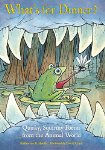 What’s for dinner:Quirky, Squirmy Poems from the Animal World
What’s for dinner:Quirky, Squirmy Poems from the Animal WorldKatherine B. Hauth
Illustrated by David Clark
Poetry
For ages 6 to 8
Charlesbridge, 2011, 978-1-57091-472-0
Animals spend a lot of their time looking for food. After all, if they don’t forage or hunt for their meals they will “croak,” and therefore “finding food / is no joke.” Some of the things animals eat might not seem at all palatable to us, but to them they are vital, and no doubt delicious as well.
In this book young readers will see how animals of different species are connected through their need to eat. One of things that we humans forget sometimes is that all animals are part of a food chain. Perhaps we forget because we are at the top of our chain most of the time. In the poem Food Chain, we see how a butterfly gets eaten by a lizard, which gets eaten by a garter snake, which then gets eaten by a roadrunner. Every animal has a place in a chain, and every food item that they eat has its place as well.
We may think that animals that eat dead things are disgusting, but in fact their dining choices serve a very useful purpose for the rest of us. The vulture for example, who is “No dainty vegetarian,” loves carrion, and this is a good thing too because if they didn’t disease-ridden dead bodies would be lying all over the place.
Nighthawks and little brown bats both love to eat insects, and they have different strategies to catch their preferred dinners. Both animals hunt at night or in the early evening and they catch their meals on the wing, swooping, and in the case of the bat scooping, the insects out of the air.
Some animals have come up with quite complicated strategies to get their food. When it is hungry the wood turtle goes around “Stompin’ its feet / and slammin’ its shell.” All the commotion causes worms to “pop up / to see who’s jamming,’” which is when the turtle eats the worms.
Children who have a fondness for things that some would consider unsavory are going to love this book. The interesting thing is that a great deal of information is wrapped up in these poems. For readers who would like to know more about the animals mentioned in the book, the author provides notes at the back of the book that are packed with more facts.
I just spent an amazing week in New Zealand for the IBBY Congress and enjoyed sharing my poetry poster, meeting New Zealand poets, soaking up a panel dedicated to poetry, chatting with a Latvian publisher of poetry, checking out poetry at the downtown library and area museums, and seeing the country's plans for their National Poetry Day (TODAY!). So fun! Here are a few highlights. So gratifying to learn we are part of a global poetry community!
 |
I had my poster printed on a scarf and then WORE my poster-scarf for the rest of the conference! Check out Mailpix.com (but get a Groupon first and it only cost $20 plus $10 for shipping!).
|
 |
| I met these poets at the conference and was excited to point out to Jenny and Paula that their work was featured on my poster. Bought Paula's massive book (pictured in blue) and got her to autograph it too! Don't miss this excellent website: nzpoetryshelf.com |
 |
She is publishing 100 individual Latvian poems as little cardboard books with art by various well-known Latvian illustrators-- to reach pre-school children and their families in particular! Check out FB.com/bikibuks
|
 |
This panel featured poetry exclusively and here Helen O'Carroll talked about verse novels including works by Holly Thompson, Allan Wolf, Kwame Alexander, Ann E. Burg, and Karen Hesse, as well as Australian and New Zealand novels in verse.
|
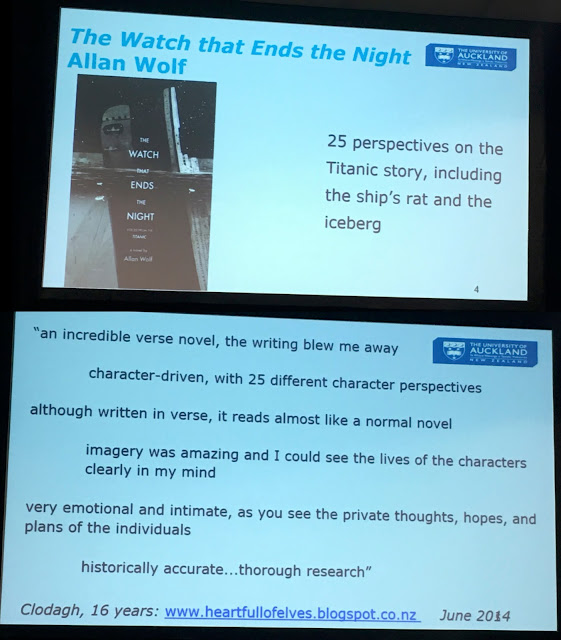 |
| Here's an example of the reader response to THE WATCH THAT ENDS THE NIGHT by Allan Wolf from a NZ teen. |
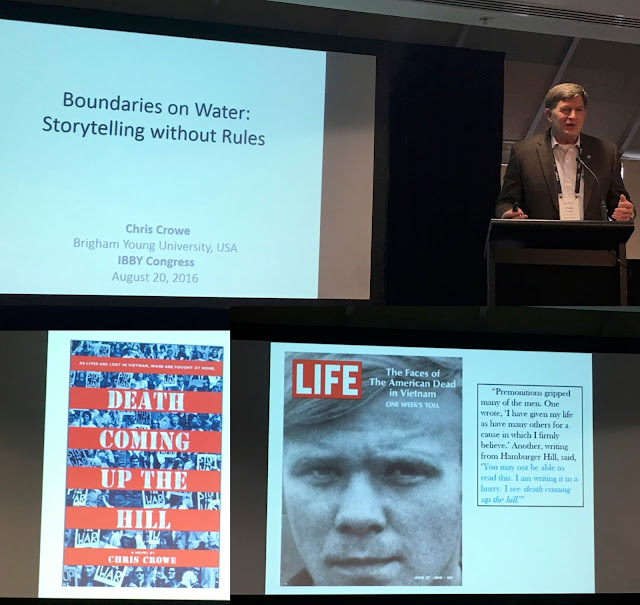 |
American professor and author Chris Crowe shared the fascinating process that emerged as he created his novel in verse, DEATH COMING UP THE HILL about a teen struggling with war in the world and in his family, written entirely in haiku and containing one syllable for each soldier who died in the Vietnam War.
|
 |
| Check out this shelf of poetry books at the downtown public library (including UNBEELIEVABLES, ECHO ECHO, WATER SINGS BLUE), plus the first issue of the NZ School Journal, THE source of literature provided to ALL NZ children for years and years-- including now. |
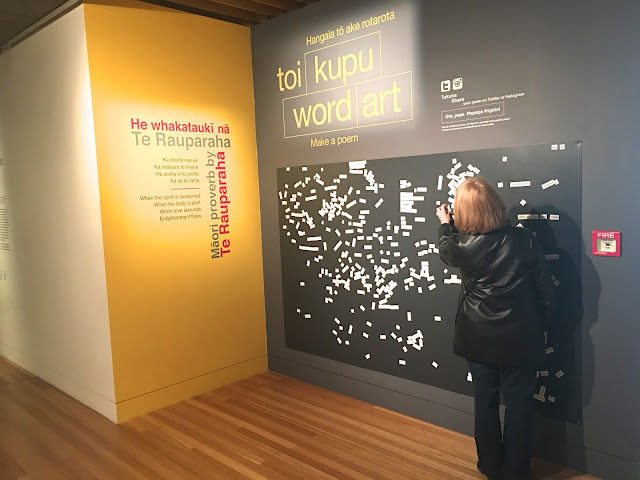 |
| A participatory magnetic poetry wall at the main cultural museum (Te Papa) in Wellington, the capital of New Zealand. |
 |
| Yes, National Poetry Day is held on the last Friday of August every year in New Zealand (since 1997) and there are tons of activities planned for all ages. Wish I could stay for it! |
Not long ago I had a day when everything seemed to go wrong. The hose attacked my ankles and I fell over. The dishwasher dumped water all over my feet. A stack of books fell over onto my toes, which hurt a lot. On and on it went until I began to seriously consider climbing into bed and staying there for the rest of the day. At least in bed I would be safe!
Today's picture book is about a charming little badger character who has a bad day, a day full of little calamities.
 The day everything went wrong
The day everything went wrongMoritz Petz
Illustrated by Amelie Jackowski
Translated by David Henry Wilson
Picture Book
For ages 5 to 7
North South, 2015, 978-0-7358-4209-0
One morning Badger wakes up and he decides that today he will only do “things I enjoy doing.” It is going to be his special day. As soon as he gets out of bed he knocks over his bedside lamp, but thankfully it does not break.
In the best of moods Badger sits down to have his breakfast, which is when he knocks over his cup and it falls to the floor and shatters. Badger is very upset because the cup was his favorite one. Badger then decides that he wants to draw a picture, but he can’t find his colored pencils anywhere. He cannot help feeling rather upset that his day, which was going to be “such a treat” is going so wrong. Perhaps he will be better off in his yard where he always has fun.
While Badger is playing outside he trips and knocks over the wheelbarrow, cutting his knee in the process. Dear me! Badger needs to do something to turn his rotten day into one that is not so full of accidents, and so he heads off to find his friends. Maybe if he leaves home his day will improve.
It turns out that Badger is not the only one having a bad day. Raccoon’s clothesline has broken, Stag has lost his ball, Squirrel has a scratch, Rabbit’s fishing line is tangled, Fox’s front door is blocked, and Mouse cannot figure out how to bake a cake. The bad day seems to be touching everyone in the forest.
Everyone has bad days sometimes, days when nothing seems to go right and when one wishes one could go back to bed. In this charming picture book we meet a badger who is having just such a day and who does his best to turn a bad day into a good one. Children who are having (or have had) a bad day of their own will really appreciate why the animals in the story are so upset.
I'm attending the biennial Congress of the International Board on Books for Young People (IBBY) in Auckland, New Zealand. This is such a wonderful event, a great opportunity to get a global glimpse of he field of children's literature and meet people from around the world and hear speakers from many countries. I'm particularly eager to check out the poetry published for young people in New Zealand (and Australia) because they are doing some very interesting things there!
I'm also presenting a poster session on how poetry is a perfect medium for crossing cultural boundaries and will share the graphics here, FYI. I'm trying something different this time and have printed my poster on a scarf which I will display during my allotted time and then WEAR afterwards! I'll try to share photos later. Meanwhile, check out the conference programme here. Very cool!

Several years ago I co-edited the IBBY journal, Bookbird, and we closed every issue with a page featuring a poem for young people by different poets from around the world (usually in English as well as in the poet's native language). I just LOVED doing that and learned so much about poetry for young people published in other countries. Anyhoo, here's a graphic that features all the poems (too small to read, but you get the idea). You can access all these prior issues of Bookbird via Project Muse, if you have access to that resource. Enjoy!
More info to come soon...
Meanwhile, head on over to Dori Reads for more Poetry Friday fun.
View Next 25 Posts

 4. Pair this poem with the picture book Vote! by Eileen Christelow (Clarion, 2003) and discuss the questions the dog and cat characters raise about the voting process that the children also share.
4. Pair this poem with the picture book Vote! by Eileen Christelow (Clarion, 2003) and discuss the questions the dog and cat characters raise about the voting process that the children also share. 

























































